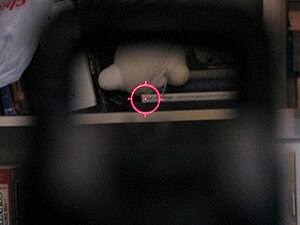
Parallax is a displacement or difference in the apparent position of an object viewed along two different lines of sight and is measured by the angle or half-angle of inclination between those two lines. Due to foreshortening, nearby objects show a larger parallax than farther objects, so parallax can be used to determine distances.

Holography is a technique that enables a wavefront to be recorded and later reconstructed. It is best known as a method of generating three-dimensional images, and has a wide range of other uses, including data storage, microscopy, and interferometry. In principle, it is possible to make a hologram for any type of wave.
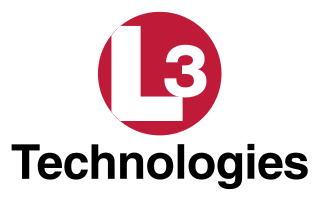
L3 Technologies, formerly L-3 Communications Holdings, was an American company that supplied command and control, communications, intelligence, surveillance and reconnaissance (C3ISR) systems and products, avionics, ocean products, training devices and services, instrumentation, aerospace, and navigation products. Its customers included the Department of Defense, Department of Homeland Security, United States Intelligence Community, NASA, aerospace contractors, and commercial telecommunications and wireless customers. In 2019, it merged with Harris Corporation to form L3Harris Technologies.

The Advanced Combat Optical Gunsight (ACOG) is a series of prismatic telescopic sights manufactured by Trijicon. The ACOG was originally designed to be used on the M16 rifle and M4 carbine, but Trijicon has also developed ACOG accessories for other firearms. Models provide fixed-power magnification levels from 1.25× to 6×. ACOG reticles are illuminated at night by an internal tritium phosphor. Some versions have an additional daytime reticle illumination via a passive external fiberoptic light pipe or are LED-illuminated using a dry battery. The first ACOG model, known as the TA01, was released in 1987.

A reticle, or reticule also known as a graticule, is a pattern of fine lines or markings built into the eyepiece of an optical device such as a telescopic sight, spotting scope, theodolite, optical microscope or the screen of an oscilloscope, to provide measurement references during visual inspections. Today, engraved lines or embedded fibers may be replaced by a digital image superimposed on a screen or eyepiece. Both terms may be used to describe any set of patterns used for aiding visual measurements and calibrations, but in modern use reticle is most commonly used for weapon sights, while graticule is more widely used for non-weapon measuring instruments such as oscilloscope display, astronomic telescopes, microscopes and slides, surveying instruments and other similar devices.
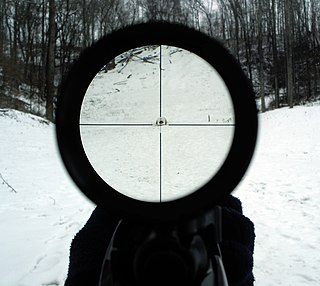
A telescopic sight, commonly called a scope informally, is an optical sighting device based on a refracting telescope. It is equipped with some form of a referencing pattern – known as a reticle – mounted in a focally appropriate position in its optical system to provide an accurate point of aim. Telescopic sights are used with all types of systems that require magnification in addition to reliable visual aiming, as opposed to non-magnifying iron sights, reflector (reflex) sights, holographic sights or laser sights, and are most commonly found on long-barrel firearms, particularly rifles, usually via a scope mount. Similar devices are also found on other platforms such as artillery, tanks and even aircraft. The optical components may be combined with optoelectronics to add night vision or smart device features.

A sight or sighting device is any device used to assist in precise visual alignment of weapons, surveying instruments, aircraft equipment, optical illumination equipment or larger optical instruments with the intended target. Sights can be a simple set or system of physical markers that serve as visual references for directly aligning the user's line of sight with the target, or optical instruments that provide an optically enhanced—often magnified—target image aligned in the same focus with an aiming point. There are also sights that actively project an illuminated point of aim onto the target itself so it can be observed by anyone with a direct view, such as laser sights and infrared illuminators on some night vision devices, as well as augmented or even virtual reality-enabled digital cameras with software algorithms that produce digitally enhanced target images.
Aimpoint AB is a Swedish optics company based in Malmö, Sweden that manufactures red dot sights.
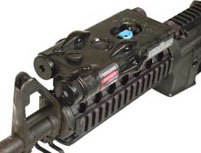
The AN/PEQ-2 Infrared Target Pointer/Illuminator/Aiming Light (ITPIAL) is a laser sight for use on rifles fitted with a Picatinny rail. It was manufactured by Insight Technology.
The Special Operations Peculiar MODification (SOPMOD) kit is an accessory system for the M4A1 carbine, CQBR, FN SCAR Mk 16/17, HK416 and other weapons used by United States Special Operations Command (USSOCOM) special forces units, though it is not specific to SOCOM. The kit allows US Special Operations Forces personnel to configure their weapons to individual preferences and customize for different mission requirements.
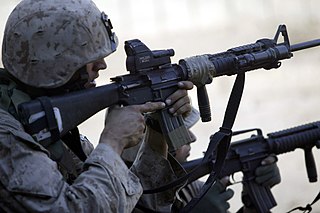
The ITL MARS is a gun sight that combines two sighting devices, a reflex sight and a laser sight, as well as a backup iron sight. It is designed and produced by ITL Optronics company, based in Israel. The laser may be either visible or infrared and can be activated as needed via a pressure switch. It has been purchased by a number of forces including the U.S. military for its M16 series weapons, Israel for its IMI Tavor TAR-21 rifle, and India for its INSAS rifle, as well as other commercial customers.
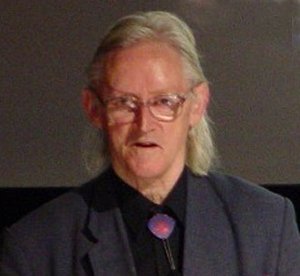
Nicholas (Nick) John Phillips was an English physicist, notable for the development of photochemical processing techniques for the colour hologram. Holograms typically used to have low signal-to-noise ratios, and Phillips is credited as the pioneer of silver halide holographic processing techniques for producing high-quality reflection holograms.
A holographic display is a type of 3D display that utilizes light diffraction to display a three-dimensional image to the viewer. Holographic displays are distinguished from other forms of 3D displays in that they do not require the viewer to wear any special glasses or use external equipment to be able to see the image, and do not cause a vergence-accommodation conflict.

A red dot sight is a common classification for a non-magnifying reflector sight that provides an illuminated red dot to the user as a point of aim. A standard design uses a red light-emitting diode (LED) at the focus of collimating optics, which generates a dot-style illuminated reticle that stays in alignment with the firearm the sight is attached to, regardless of eye position.
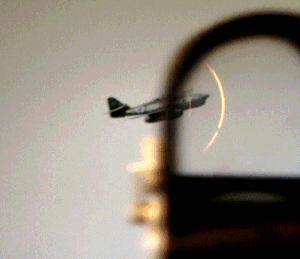
A reflector sight or reflex sight is an optical sight that allows the user to look through a partially reflecting glass element and see an illuminated projection of an aiming point or some other image superimposed on the field of view. These sights work on the simple optical principle that anything at the focus of a lens or curved mirror will appear to be sitting in front of the viewer at infinity. Reflector sights employ some form of "reflector" to allow the viewer to see the infinity image and the field of view at the same time, either by bouncing the image created by lens off a slanted glass plate, or by using a mostly clear curved glass reflector that images the reticle while the viewer looks through the reflector. Since the reticle is at infinity, it stays in alignment with the device to which the sight is attached regardless of the viewer's eye position, removing most of the parallax and other sighting errors found in simple sighting devices.

A holographic weapon sight or holographic diffraction sight is a non-magnifying gunsight that allows the user to look through a glass optical window and see a holographic reticle image superimposed at a distance on the field of view. The hologram of the reticle is built into the window and is illuminated by a laser diode.

A collimator sight is a type of optical sight that allows the user looking into it to see an illuminated aiming point aligned with the device the sight is attached to, regardless of eye position. They are also referred to as collimating sights or "occluded eye gunsight" (OEG).

A sight magnifier is an optical telescope that can be paired with a non-magnifying optical sight on a weapon to create a telescopic sight. They work with the parallel collimated reticle image produced by red dot sights and holographic weapon sights. They may synonymously be referred to as a red dot magnifier, reflex sight magnifier, holographic sight magnifier, or flip to side magnifiers.

The Advanced Target Pointer / Illuminator / Aiming Light, ATPIALAN/PEQ-15 known colloquially as the "PEQ-15" [] produced by L3Harris ; is a multifunction IR Target Pointer & Illuminator, a.k.a. a Laser Aiming Module (LAM) for use as a rifle attachment, using a Picatinny rail mounting system.

